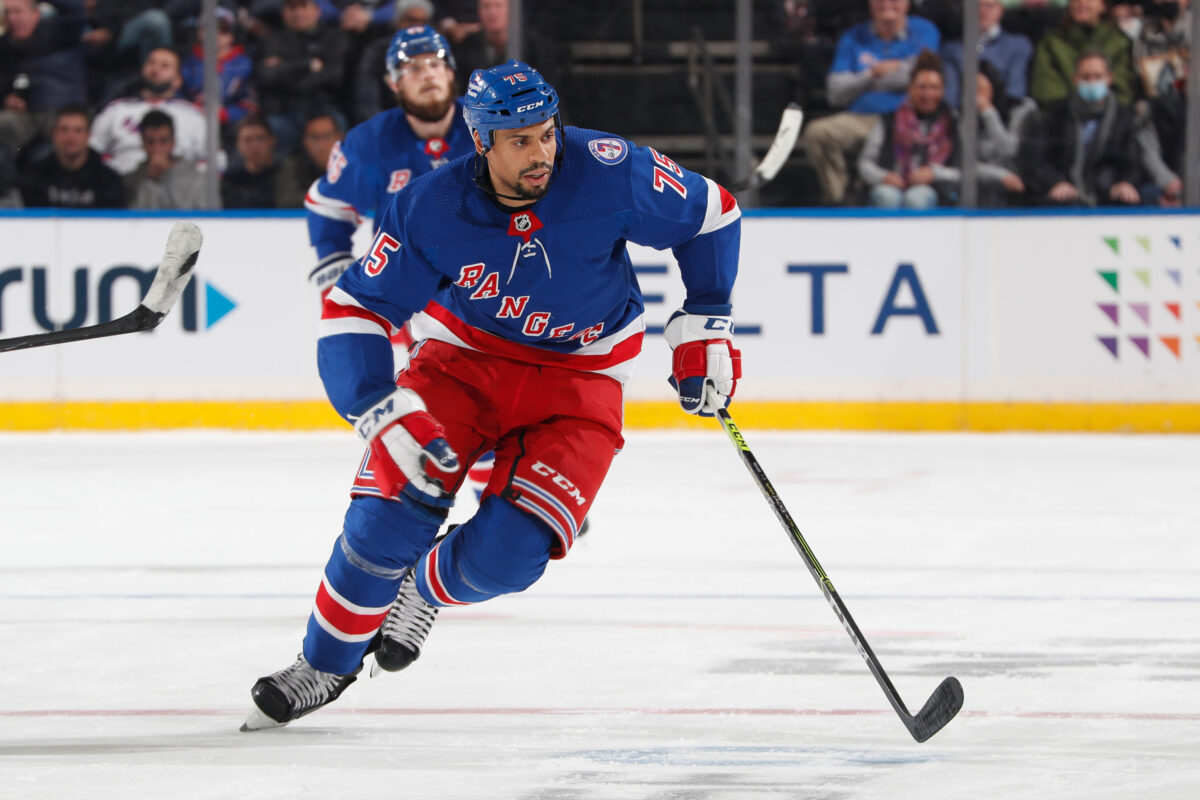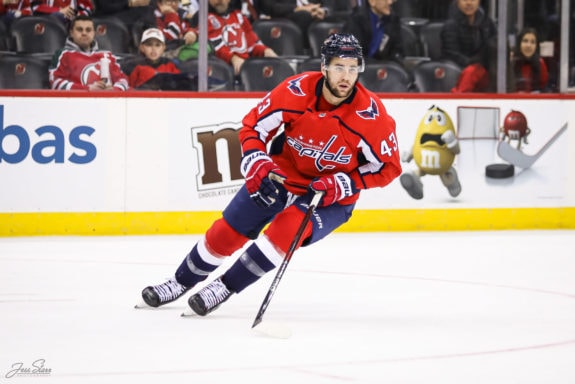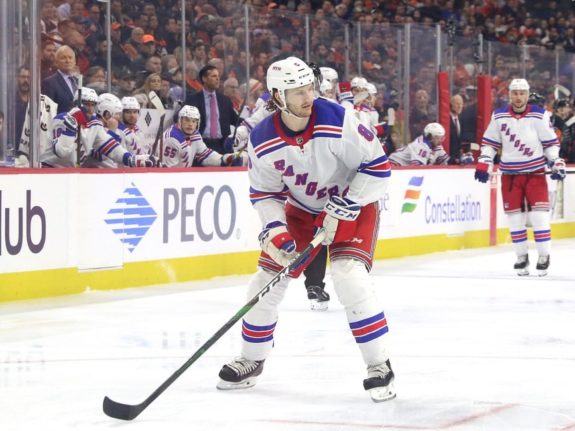As New York Rangers forward Ryan Reaves skated to the penalty box following his beatdown of the Montreal Canadiens’ Michael Pezzetta on Nov. 16, the Madison Square Garden crowd roaring in approval, Kaapo Kakko tapped his stick enthusiastically against the boards, his eyes wide with amazement and wearing a broad smile in appreciation of the teammate who has assumed such an important role this season.
Yet for anyone who follows the Rangers, it was easy to detect another emotion that fueled Kakko’s reaction: relief.
Kakko is only 20 years old, but he’s in his third season with the Blueshirts since being the No. 2 overall pick in the 2019 NHL draft. That’s plenty long enough for the native of Turku, Finland to have learned that Reaves’ arrival has heralded a long-awaited new era and reclaimed identity for his team.

Rangers forward Ryan Reaves (Photo by Jared Silber/NHLI via Getty Images)
The Rangers simply don’t get pushed around anymore, something that Kakko had experienced throughout his young NHL career but has seen come to an end in abrupt fashion in 2021-22. That’s due largely to Reaves, who’s looking like a bargain since being acquired from the Vegas Golden Knights in July for a 2022 third-round pick.
Reaves has been the right player at the right time for these Blueshirts. The league’s most feared fighter warned opponents during his preseason news conference that the bad old days of the Rangers being physically abused and intimidated were over, vowing to hold anyone who took liberties with his new teammates accountable. Those words have resonated as Reaves has cast a long shadow from the bench and on the ice, with plenty of textbook examples of his effect accruing through the season’s first two months.
Rangers’ Usual Nemeses Have Been Non-Factors Against Them This Season
Though a segment of the fan base howled when Reaves was brought in, those critics complaining that the Rangers were overreacting to the Tom Wilson incident of last season, proof of the wisdom of the move started rolling in almost immediately. Though the Rangers suffered a desultory 5-1 loss to the Washington Capitals in the teams’ much-hyped opener Oct. 13, Wilson, who has spent a nine-year career pounding away at the Blueshirts, declined to try imposing his will in the fashion he usually does when facing them.
Five days later, the Rangers took on the Toronto Maple Leafs, who boast another of their longtime tormentors in Wayne Simmonds. Yet Simmonds was mysteriously quiet – other than a brief shouting match with Reaves from their respective benches, which it seems safe to assume didn’t go well for the Leafs power forward, who came under a sharp glare from the 6-foot-2, 225-pound Rangers enforcer.

Washington Capitals forward Tom Wilson (Jess Starr/The Hockey Writers)
Perhaps nothing brought Reaves’ impact into greater focus, though, than the Blueshirts’ 4-1 road win over the archrival New York Islanders on Nov. 24. The Identity Line of Cal Clutterbuck, Casey Cizikas and Matt Martin, which usually plays a significant role in establishing Islander physical dominance over the Rangers, was this time marginalized while their counterparts, the line of Reaves, Kevin Rooney and Barclay Goodrow, wore down the Isles with their hitting and hard work in the offensive zone. Rooney scoring twice off assists from Reaves was the cherry on top of an eye-opening performance that seemed to fully serve notice that times have changed.
“That’s why we went out and got (Reaves). I had him in Vegas and I knew what he’s all about, so you play a lot more comfortable with a guy like him in your lineup,” coach Gerard Gallant said last month. “And he’s played well for us, so it’s been perfect.”
Related: Rangers’ Longtime Failure to Protect Players Led to Wilson Incident
Reaves is back with his perfect coach in Gallant, who understands how to get the most out of him while employing No. 75 as the means to imbue the hard-nosed style and defiant attitude with which Gallant wants his teams to play, mirroring his own career as an edgy, physical NHL forward.
Reaves’ influence has of course gone far beyond his reputation as a fighter. In what should have been predictable, the 34-year-old has emerged as one of the veteran leaders in the dressing room, especially for the Rangers’ group of up-and-coming young players, who like Kakko seem to revere him. And as Gallant said, his play has been excellent. Reaves is averaging close to five hits per game, and those seem to be increasing in intensity of late, as he’s punishing opposing forwards and defenseman alike with bone-crunching checks.

Rangers coach Gerard Gallant (Jess Starr/The Hockey Writers)
That’s given the Rangers what they haven’t had since the Black-and-Blueshirts era of a decade ago: A regularly-used fourth line that provides a formidable forecheck, defenseman often shying away from the puck in the corners or committing turnovers with Reaves and his linemates bearing down on them. The Reaves-Goodrow-Rooney trio has been a physical force that most teams haven’t been able to handle, flipping the script on what opponents routinely did to them before 2021-22.
Reaves Has Ended Bullying of Rangers’ Stars
Yet Reaves’ single biggest nightly influence is the fear factor he imparts on opponents, the specter of being on the receiving end of the kind of hammer punches delivered to Pezzetta after he foolishly challenged the Rangers’ tough guy. The result of that has been a collective exhale from the Blueshirts’ high-end skill players, who finally feel like they can fully focus on their jobs.
“Having him on the bench has everyone puff their chest out a little more and feel a little safer,” star defenseman Adam Fox said, articulating what’s become apparent to everyone. “I think he obviously keeps other teams’ guys a little in check as well and maybe they know they can’t take as much liberty, and you know you gotta answer to him if you do do something he doesn’t like, so yeah, I think having a guy like him allows everyone to play a little bigger for sure.
” … His presence definitely changes the attitude of the team a little bit.”
It’s true. The Rangers’ ongoing transformation into a more gritty outfit hasn’t happened just because they added Reaves, Goodrow, Sammy Blais (now out for the season), Dryden Hunt and Patrik Nemeth during the offseason. It’s not only a change in personnel, it’s a change in mental approach.
It’s why Jacob Trouba’s nasty edge has fully emerged in his third season in New York. It’s why Chris Kreider has thrown the body more and been more engaged physically than in seasons past. It’s why Alexis Lafreniere, who played a more jagged style in juniors before being drafted No. 1 overall last year, has started to rediscover that element of his game. It’s why Fox, with 60 career penalty minutes in 149 games, got into a scrum with Boston Bruins defenseman Charlie McAvoy in the Rangers’ 5-2 victory Nov. 26.
And it’s at least partially why usually mild-mannered star left wing Artemi Panarin, 5-11 and 170 pounds, fired his glove at Bruins pest Brad Marchand at the end of that contest (a resounding win over yet another team that’s spent years taking liberties with the Rangers).

Rangers defenseman Jacob Trouba (Amy Irvin / The Hockey Writers)
The newfound bravado stems from some combination of the infectious swagger Gallant has worked to instill, and the plain fact that Reaves’ teammates know they have much wider latitude to stand up to opponents with Reaves sitting on their bench. Only the players know which factor is more significant in that equation, but in the big picture, it doesn’t really matter.
Reaves’ Contributions Also Lifting Rangers’ Chemistry, Togetherness
Because with the Rangers apparently making a successful switch away from pretty playmaking to the more abrasive, meat-and-potatoes style of play desired by the front office, and their high-end offensive players feeling at ease as they go about the business of generating goals, it’s difficult to understate the ramifications of Reaves’ presence.
The Blueshirts are playing a more sound, simple, bold brand of hockey. Their scorers aren’t worried about being beaten up anymore. With the NHL’s most intimidating pugilist on their side, they’re increasingly willing stand up for each other – which has led to improved team cohesiveness, chemistry and accountability.
Sounds like the final blow to the analytics-based argument, one that’s been in its death throes for a while now, that Tough Guys Don’t Help You Win, doesn’t it?

Reaves with the Vegas Golden Knights (Amy Irvin / The Hockey Writers)
“I’m not getting a lot of dance partners these days,” said Reaves, whose lopsided bout with Pezzetta is his only fight this season. “But I think other teams know that because I’m in the lineup every night that they’ve got to play a little bit lighter against us.”
When Wilson ran wild at MSG on May 3, tossing around Panarin and now-former Ranger Pavel Buchnevich, he also taunted the Rangers by flexing in the penalty box and then, after finally being sent off, reportedly yelled, “They’ve got no one for me!” as he headed down the corridor. (From ‘Rangers Ready to Flaunt New Muscle Against Tom Wilson – For Better or Worse’, New York Post, 10/12/21)
Thing is, Wilson was right. Yet that evening, one of the organization’s lowest points in some time, spawned a long-overdue re-evaluation of priorities that has played a crucial role in the remade Rangers’ 17-4-3 burst out of the game this season. Can anyone reasonably envision Wilson – or anyone else – pulling that again without having to endure Reaves’ brand of fearsome retaliation?
“That’s what I’m here for,” Reaves said.
His teammates and coach, not to mention the Rangers’ front office, couldn’t be happier or more relieved about that.
